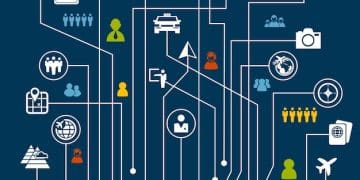US Presidential Elections: Historical Analysis & 2025 Impact

A Historical Analysis of US Presidential Elections and Their Influence on 2025 Politics reveals evolving campaign strategies, demographic shifts, and policy trends shaping the upcoming election’s landscape and potential outcomes.
Understanding the historical context of US presidential elections is crucial for interpreting the current political climate and predicting potential outcomes in 2025. This article provides a historical analysis of US presidential elections and their influence on 2025 politics, exploring key trends, shifts, and factors that continue to shape the electoral landscape.
The Evolution of US Presidential Campaigns
US presidential campaigns have undergone significant transformations since the nation’s founding. Early campaigns relied on personal connections and local networks, while modern campaigns are characterized by sophisticated data analytics and multimedia strategies.
Early Campaign Strategies
In the early days of the republic, presidential campaigns were far less elaborate than they are today. Candidates often relied on surrogates to campaign on their behalf, and direct engagement with voters was limited.
The Rise of Mass Media
The advent of mass media, including radio and television, revolutionized presidential campaigns. Candidates could now reach millions of voters simultaneously, and media appearances became increasingly important.
- The use of television advertising in the 1950s and 1960s transformed campaign messaging.
- Social media has become a dominant force in modern campaigns, allowing for direct interaction with voters.
- Data analytics now play a crucial role in targeting voters with personalized messages.
Today’s campaigns are highly sophisticated operations that rely on data-driven strategies and cutting-edge technology to connect with voters and mobilize support.

Demographic Shifts and Voting Patterns
Demographic shifts have profoundly impacted US presidential elections over time. Changes in the population’s age, race, ethnicity, and geographic distribution have altered voting patterns and election outcomes.
The Impact of the Baby Boomers
The baby boomer generation, born after World War II, exerted considerable influence on US politics as they came of voting age. Their sheer numbers and diverse political views have shaped presidential elections for decades.
The Growing Influence of Minority Voters
The increasing diversity of the US population has led to a growing influence of minority voters in presidential elections. Candidates must now appeal to a broad range of ethnic and racial groups to win elections.
- The rise of the Latino vote has transformed electoral politics in states like Florida and Texas.
- African American voters continue to be a crucial constituency for the Democratic Party.
- Asian American voters are an increasingly important demographic in states like California and Nevada.
Understanding these demographic shifts and their impact on voting patterns is essential for predicting future election outcomes. Campaigns must adapt to the changing demographics of the electorate to build winning coalitions.
The Role of Third-Party Candidates
Third-party candidates have often played a spoiler role in US presidential elections, impacting the outcome by siphoning off votes from the major party candidates. While third-party candidates rarely win elections, they can influence the national conversation and push the major parties to address specific issues.
Historical Examples of Third-Party Influence
Several third-party candidates have had a significant impact on US presidential elections throughout history. Theodore Roosevelt’s 1912 campaign as a Progressive Party candidate split the Republican vote and helped elect Woodrow Wilson.
The Impact of Third-Party Platforms
Third-party platforms often highlight issues that are not being adequately addressed by the major parties. This can force the major parties to adopt new positions in response to public demand.

Whether they are advocating for environmental protection, fiscal responsibility, or social justice, third-party candidates can play a crucial role in shaping the political agenda.
Policy Trends and Campaign Promises
Policy trends and campaign promises have long been central to US presidential elections. Candidates often run on specific policy platforms, promising to address key issues and enact reforms if elected.
The Evolution of Economic Policy Debates
Economic policy debates have been a constant feature of US presidential elections. Candidates often differ on issues such as taxation, regulation, and trade, reflecting different ideological perspectives.
The Rise of Social and Cultural Issues
Social and cultural issues have become increasingly prominent in presidential elections in recent decades. Debates over issues such as abortion, same-sex marriage, and immigration have shaped the political landscape.
The Influence of Political Polarization
Political polarization has become a defining feature of US politics in recent years. The growing divide between Democrats and Republicans has made it more difficult to find common ground on key issues and has contributed to a more contentious political climate. This polarization significantly influences presidential elections, leading to less willingness to cross party lines.
- Voters are increasingly likely to identify strongly with one political party.
- Party loyalty can trump ideological consistency on specific issues.
- The increasing difficulty of finding bipartisan solutions can lead to greater frustration with the political process.
Candidates must navigate this highly polarized environment to build broad coalitions and win elections. This often requires appealing to moderate voters without alienating their base.
Looking Ahead: The 2025 Election
As we look ahead to the 2025 election, several key factors are likely to shape the political landscape. These include demographic trends, policy debates, and the overall political climate.
Potential Key Issues
Several key issues are likely to dominate the 2025 election. These include economic inequality, healthcare reform, climate change, and immigration. Candidates will need to offer clear and compelling visions for addressing these challenges.
The Role of Technology
Technology will continue to play a crucial role in presidential elections. Candidates will need to effectively utilize social media, data analytics, and other digital tools to reach voters and mobilize support.
The 2025 election will be shaped by a combination of these factors, and the outcome will have significant implications for the future of the United States. Understanding the historical context and current trends is essential for navigating the challenges and opportunities that lie ahead.
| Key Point | Brief Description |
|---|---|
| 📈 Campaign Evolution | From grassroots to digital strategies. |
| 🗳️ Demographic Shifts | Minority voters’ growing influence. |
| 🏛️ Policy & Promises | Economic and social issues take center stage. |
| polarized country️ Polarization Effects | Impact of party divisions on election results. |
Frequently Asked Questions
▼
Campaign strategies have evolved from grassroots efforts to data-driven digital campaigns. The integration of mass media and technology has transformed voter outreach and messaging.
▼
Demographic shifts significantly impact elections. The rise of minority and younger voters influences campaign strategies. Candidates must adapt to capture these diverse groups.
▼
Policy debates shape elections by highlighting key differences between candidates. Economic, social, and cultural issues influence voter decisions based on alignment with platforms.
▼
Third-party candidates, while rarely winning, often introduce new issues and can affect outcomes by diverting votes. They can force major parties to address overlooked concerns.
▼
Political polarization intensifies elections as voters align strongly with parties. This reduces cross-party support and can lead to volatile and closely contested results.
Conclusion
In conclusion, understanding the historical context of US presidential elections is vital for interpreting current political trends and anticipating the potential dynamics of the 2025 election. Campaign strategies, demographic shifts, policy debates, the role of third parties, and the impact of political polarization all contribute to the complex tapestry of US electoral politics.





